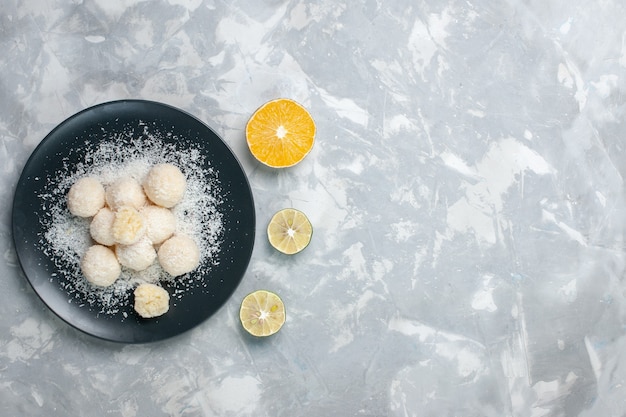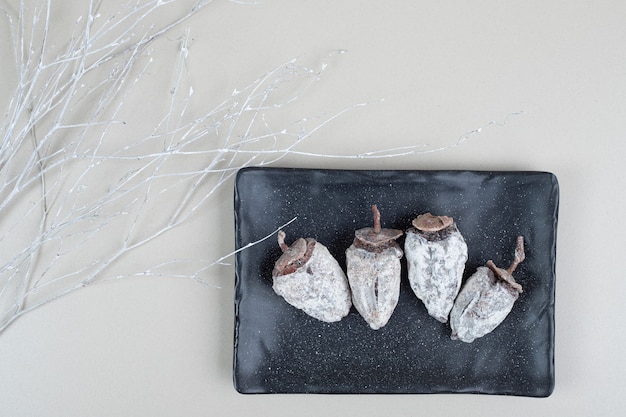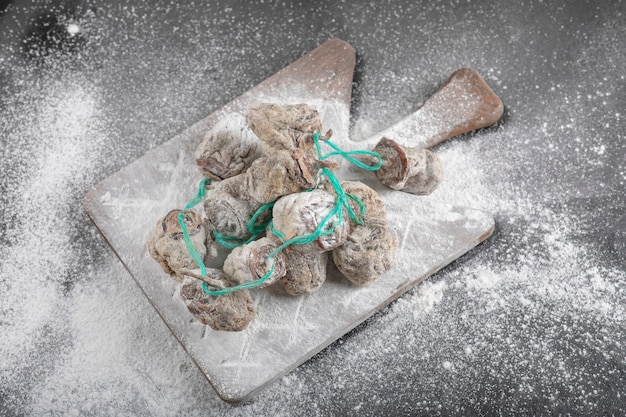Let's be real, folks. Fresh seafood isn't always readily available, especially for those of us who aren't living near the coast. But that doesn't mean you have to miss out on the deliciousness of scallops! frozen scallops are a fantastic alternative, and with a few simple tricks, they can be just as good as the fresh ones.
I’ve been a seafood fanatic for years, and frozen scallops have been a lifesaver on countless occasions. They’re convenient, budget-friendly, and with the right approach, they can be incredibly tasty. This guide is your roadmap to transforming those frozen treasures into a culinary masterpiece – no fancy chef skills required!
(Part 1) Choosing the Right Scallops

The Frozen Scallop Landscape
The first step in this journey is picking the right scallops. It’s a bit of a jungle out there, with a wide variety of frozen scallops, from budget-friendly options to premium picks.
My personal preference? dry-packed scallops. They haven't been pre-soaked in a salty solution, which can leave them mushy and less flavorful. Dry-packed scallops tend to have a more pronounced texture and taste, making them worth the slightly higher price tag.
Decoding the Packaging
When you’re staring at those freezer aisle shelves, don’t just grab the first pack you see. Take a minute to check the packaging for these key details:
- Ingredient List: Keep it simple! Look for just "scallops" – no added fillers, phosphates, or preservatives. These can mask the natural flavor and mess with the texture.
- sea scallops vs. bay scallops: Sea scallops, usually larger and meatier, are generally a bit more forgiving for cooking. Bay scallops, while delicious, can be a bit more finicky.
- Size Matters: Scallops are labeled with a "U" number, like "U10". A lower "U" number means larger scallops – "U10" means there are 10 scallops per pound.
- The "Use-By" Date: This is your freshness indicator. Don't be afraid to choose a pack with a later date.
A Tale of Frozen Scallop Woes
Speaking of choosing wisely, I have a cautionary tale. Remember that time I was rushing to grab some dinner ingredients? I grabbed the first pack of frozen scallops without even checking the packaging. Big mistake! They were so waterlogged, they were practically swimming. Lesson learned: take your time and read the label!
(Part 2) Thaw Those Scallops

The Absolute No-No
The worst thing you can do is thaw scallops at room temperature. It's a breeding ground for bacteria, and that's a recipe for a bad time (and a potential stomachache). Think of it like leaving a juicy steak out on the counter – you wouldn't do that, right?
The Fridge Method
My preferred method is to thaw scallops in the refrigerator overnight. This gentle approach allows them to defrost slowly and evenly, preserving their moisture and texture. Just pop them in a bowl or container and place them on a shelf in your fridge.
The Time Crunch Alternative
But I get it, sometimes you need dinner on the table now. If you're in a rush, you can thaw scallops in a bowl of cold water. Change the water every 30 minutes to keep it chilled, and make sure your scallops are completely submerged. This method can take 30 minutes to an hour, depending on the size.
(Part 3) Prepping for Perfection

Pat it Dry
Once those scallops are thawed, give them a good pat-dry with some paper towels. This will remove excess moisture, which can lead to steaming instead of searing.
The Muscle Removal (Optional)
Now, this is a point of debate, but I like to remove the muscle from my scallops. It’s that tough little piece sometimes found in the center. It can be a bit chewy, and I find it takes away from the overall texture.
Removing it is a simple task: grab it with your fingers and gently pull it out. If it’s stubborn, a small, sharp knife will do the trick.
Seasoning with Simplicity
Now you’re ready to season your scallops. Don't go overboard – you want to enhance, not overpower, their delicate flavor.
My go-to seasoning is simple: salt, pepper, and a squeeze of lemon juice. Sometimes I’ll add a pinch of garlic powder or paprika for a subtle kick.
A Word on Salt
Don’t be afraid to use a good amount of salt! It really brings out the flavor of the scallops. I prefer kosher salt, but any good quality sea salt will do.
(Part 4) cooking time!
The Searing Method
This is my favorite way to cook scallops. It gives them a beautiful, golden-brown crust and a soft, tender interior.
Here's how to do it:
- Heat the Pan: Use a cast iron skillet or heavy-bottomed pan. Heat it over medium-high heat until it's smoking hot.
- Add Oil: Use a neutral oil, like grapeseed or canola oil. Don’t overcrowd the pan – cook scallops in batches if necessary.
- Sear It Up: Place the scallops in the hot pan and leave them undisturbed for at least 3 minutes. This creates the beautiful crust. After 3 minutes, flip them and cook for another 1-2 minutes.
- Check for Doneness: The scallops should be golden brown on both sides and opaque in the center. They’ll be firm to the touch, but not rubbery.
Beyond Searing: Other Cooking Methods
Searing isn’t the only way to cook scallops! Here are some other options:
- Pan-Frying: Similar to searing, but over medium heat. This is a good option if you prefer a less crispy crust.
- Baking: Preheat your oven to 400°F (200°C). Place the scallops on a baking sheet lined with parchment paper. Bake for 10-12 minutes, or until they're cooked through.
- Grilling: Preheat your grill to medium-high heat. Grill the scallops for 2-3 minutes per side, or until they're cooked through.
- Sautéing: Use a bit of butter and olive oil in a pan over medium heat. Cook scallops for 2-3 minutes per side, or until they're cooked through.
(Part 5) The Danger of Overcooked Scallops
Don't Overdo It!
Remember, scallops are delicate. They cook quickly, and overcooking will turn them into rubbery, dry disappointments.
Signs of a Perfectly Cooked Scallop
Here's how to tell if your scallops are ready:
- Visual Cues: Look for a golden-brown crust on the outside and an opaque center.
- Texture Test: They should be firm to the touch, but not hard or rubbery.
- internal temperature: Use a meat thermometer for extra assurance. Scallops are done when they reach an internal temperature of 140°F (60°C).
(Part 6) Serving Up Scallop Bliss
Simple and Stunning
Once your scallops are cooked to perfection, it’s time to show them off. There are endless ways to serve them, but I like to keep things simple and let the scallops shine.
Here are some ideas to get your creative juices flowing:
- Lemon Butter Drizzle: This classic combo is always a winner. Melt some butter in a pan, add a squeeze of lemon juice, and pour it over the scallops.
- Risotto Rhapsody: Creamy risotto is the perfect complement to the delicate flavor of scallops.
- Salad Superstar: Add cooked scallops to your favorite salad for a protein boost.
- Pasta Perfection: Toss cooked scallops with your favorite pasta sauce and some fresh herbs.
side dish Symphony
No meal is complete without a few side dishes, and here are some of my favorites that pair beautifully with scallops:
- roasted asparagus: The slightly bitter flavor of asparagus complements the sweetness of scallops.
- roasted brussels sprouts: These crispy sprouts are a delicious side dish for any seafood meal.
- Sautéed Spinach: A simple and healthy side dish.
- Garlic Bread: A classic comfort food that pairs well with scallops.
(Part 7) A Few More Tips from the Kitchen
Leftover Scallops? No Problem!
If you find yourself with leftover scallops, don't despair! They can be used in a variety of dishes. Try them in a pasta salad, a quiche, or even a stir-fry.
Embrace Experimentation!
Cooking is all about trying new things. Don't be afraid to experiment with different herbs, spices, and sauces to find your favorite combinations. You might be surprised by what you discover!
Presentation Matters
Food is an art, so take a few minutes to arrange your scallops beautifully on a plate. Use fresh herbs and edible flowers for a touch of elegance.
Share the Love!
Once you've created your masterpiece, share it with your loved ones. After all, what’s a good meal without good company?
(Part 8) FAQs
1. Can I Freeze Thawed Scallops Again?
It's not recommended. Freezing and thawing scallops multiple times can affect their texture and flavor.
2. How Long Can I Keep Frozen Scallops in the Freezer?
Frozen scallops can last for up to 3 months in the freezer. Store them in a freezer-safe container or bag.
3. How Do I Know If My Frozen Scallops Are Still Good?
They should have a firm texture and a pleasant, fresh smell. If they have an off-color, smell, or texture, it's best to discard them.
4. Can I Cook Frozen Scallops Without Thawing Them First?
It's not ideal. Thawing scallops first allows for more even cooking. If you must cook them frozen, increase the cooking time.
5. What Are Some Good Wines to Pair with Scallops?
Scallops are versatile and pair well with many wines. Some popular choices include:
- Chardonnay
- Sauvignon Blanc
- Pinot Grigio
- Riesling
- Dry Rosé
(Part 9) A Final Word
There you have it – your comprehensive guide to cooking frozen scallops to perfection. It's all about choosing the right scallops, thawing them properly, and using a little care and attention in the kitchen. With a little practice, you’ll be whipping up delicious scallop dishes in no time!
So, go forth, experiment, and enjoy the wonderful world of frozen scallops! And remember, if you have any questions, don't hesitate to ask. I'm always happy to help.
Everyone is watching

How to Cook Frozen Lobster Tails Perfectly: A Step-by-Step Guide
RecipesLobster. Just the word conjures up images of lavish meals, special occasions, and a taste of luxury. But let's...

Pigs in a Blanket Cooking Time: How Long to Bake for Perfect Results
RecipesAh, pigs in a blanket. Just the name conjures up images of those delightful little parcels of crispy pastry en...

Pork Fillet Cooking Time: How Long to Cook It Perfectly
RecipesPork fillet, or tenderloin as it's sometimes called, is a real favourite in our house. It's so versatile, and...

The Ultimate Guide to Cooking Delicious Frankfurters
RecipesLet's face it, we all love a good frankfurter. It's a classic, simple, and always satisfying. But let's be rea...

Wolf Meat Recipes: A Guide to Cooking Wild Game
RecipesLet's be honest, you don't see wolf meat at your local butcher shop every day. It's a bit of a wild card, but ...
